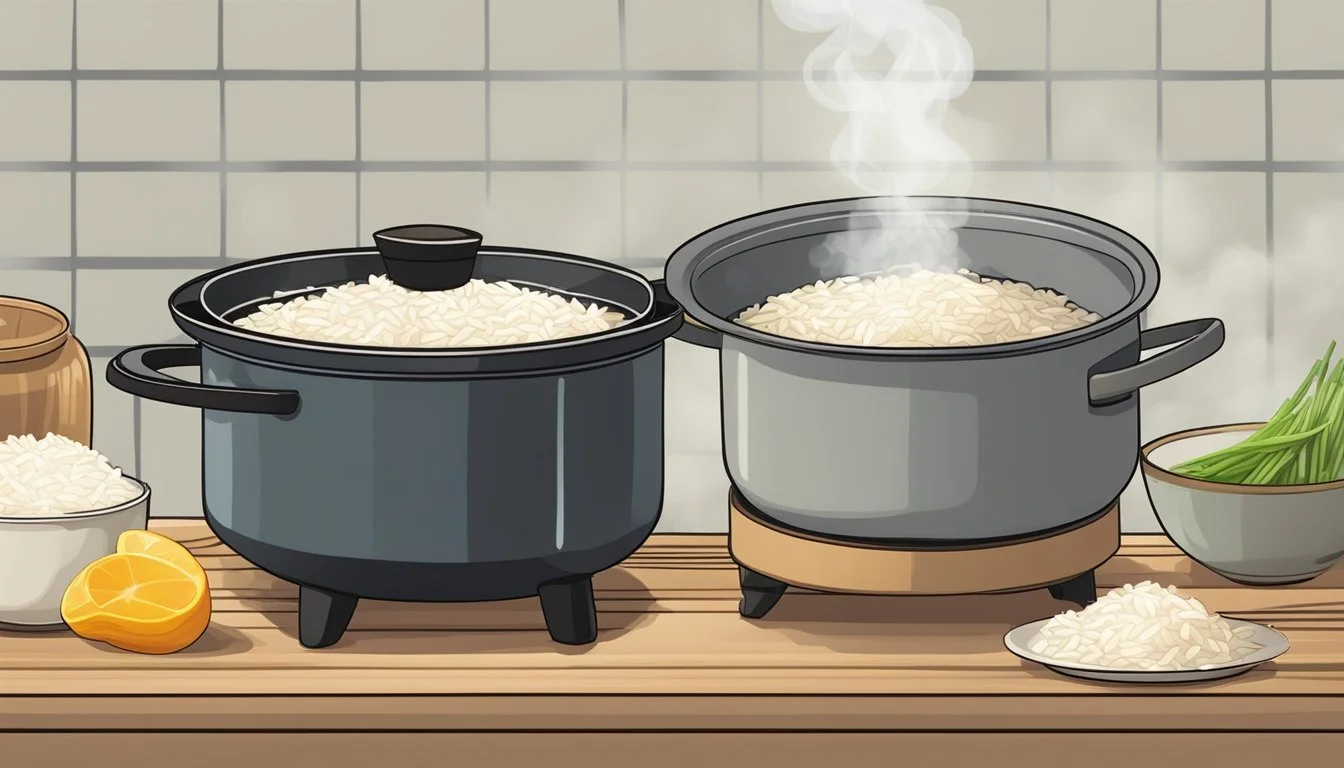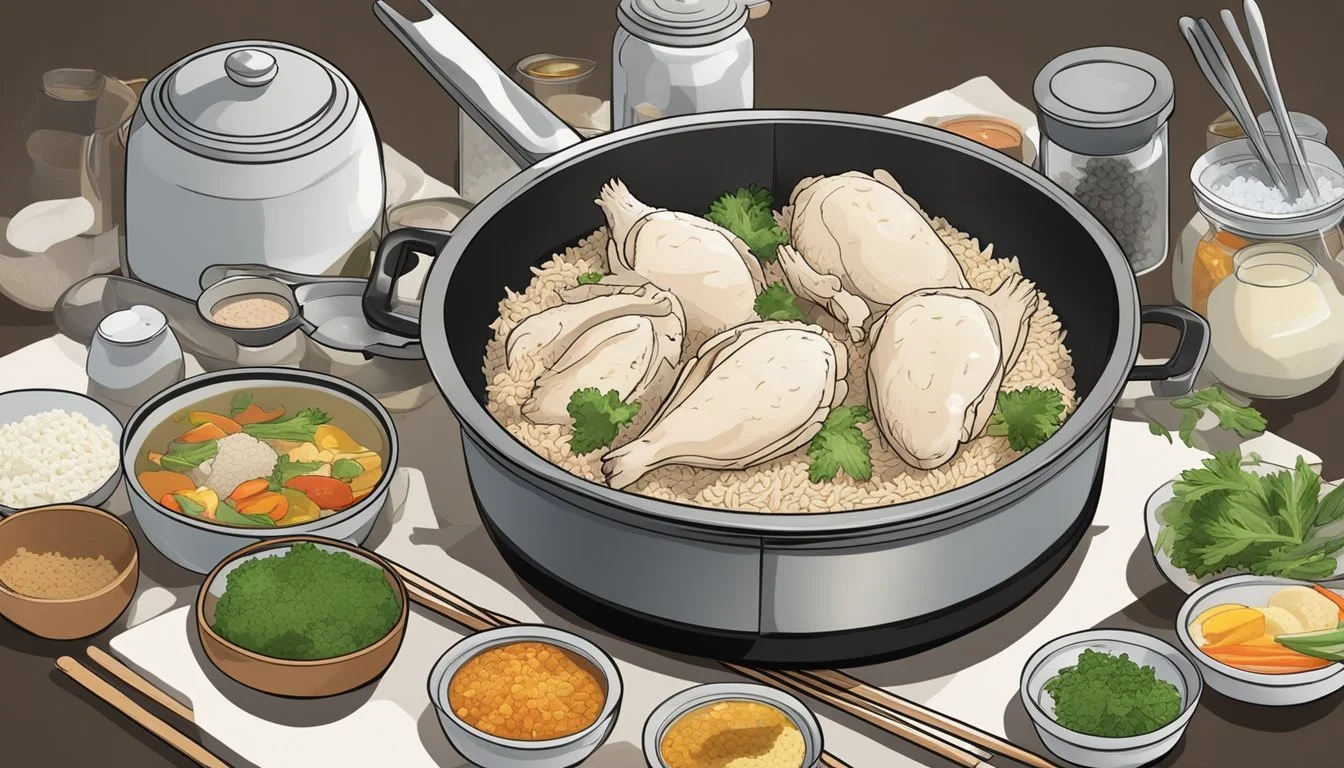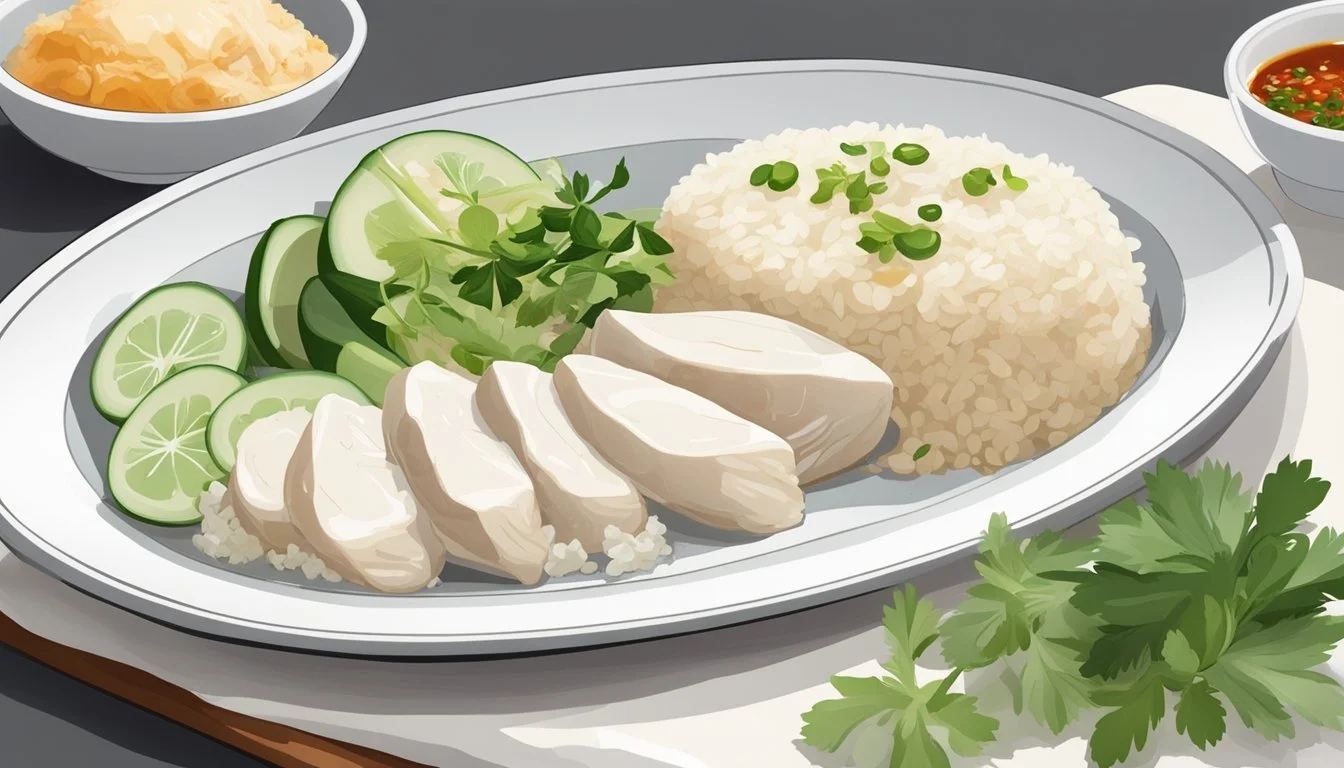Best Way to Reheat Hainanese Chicken Rice
Tips for Retaining Flavor and Tenderness
Hainanese Chicken Rice (What wine goes well with rice?), a dish renowned for its succulent chicken and aromatic rice, is a staple in Southeast Asian cuisine that has spread in popularity across the globe. The challenge often faced by aficionados of this dish is reheating it in a way that preserves the tender texture of the chicken and the distinct flavor of the rice, which is cooked in a rich, flavorful broth. Achieving this requires knowledge of the right techniques, which allow for the dish to be enjoyed as if freshly made, even after refrigeration.
It's crucial to approach the reheating process with care because the delicate skin of the Hainanese chicken and the integrity of the rice are essential components of the dish's appeal. Different methods such as steaming, oven baking, or microwaving, each offer unique benefits and can be tailored to personal preferences or kitchen equipment availability. The key lies in the methodical application of heat to ensure even warming without overcooking, ensuring that the natural juices of the chicken are retained and the rice does not become dry.
Proper reheating can also revive the accompanying sauces, which complement the chicken rice with their bold flavors. This is especially important as these sauces—garlic, ginger, and chili—are integral to the full Hainanese Chicken Rice experience. They imbue the dish with a depth of flavor that can transform a simple reheated meal into a culinary delight reminiscent of its original state.
Origins and Significance
Exploring the Hainanese chicken rice, it is key to understand its cultural importance and evolution into a dish celebrated as a national symbol in Singapore.
Cultural Roots of Hainanese Chicken Rice
Originating from the Hainan province in southern China, Hainanese chicken rice has significant cultural heritage. The dish features the Wenchang chicken, a type associated with the Wenchang city in Hainan. It made its way to various parts of Asia, including Singapore, Malaysia, and Thailand, through waves of Hainanese migration.
Hainanese Chicken Rice as a National Dish
In Singapore, Hainanese chicken rice has transcended its immigrant roots to become a national dish. This hallmark of Singaporean cuisine reflects a blend of local culinary practices with the Hainanese traditions. Its adoption and adaptation reflect Singapore's multicultural society, signaling its importance within the Southeast Asian culinary landscape.
Preparing the Chicken
Proper preparation of the chicken is essential for achieving tender, juicy meat in Hainanese Chicken Rice. This section details how to select, clean, poach, and cool the chicken to ensure optimal flavor and texture.
Selecting the Right Chicken
A whole chicken is preferred for its ability to retain moisture throughout the poaching process. One should select a fresh, plump bird with a healthy skin tone and no off odors. For the juiciest, most tender meat, aim for a chicken that has a balanced distribution of breast and leg meat.
Cleaning and Preparing the Chicken
Before poaching, cleaning the chicken is crucial. One must thoroughly rinse the chicken under cold water and then pat it dry with paper towels. Next, generously season the cavity and skin with salt to help cleanse and prepare the meat for cooking, as salt aids in moisture retention and flavor penetration.
Poaching Techniques for Juicy Meat
For poached chicken that is moist and full of flavor, temperature control is key. Gently lower the chicken into a pot of simmering chicken stock or chicken soup, ensuring the liquid covers the bird. Maintain a low simmer; vigorous boiling can toughen the meat. Poach until the internal temperature of the thickest part of the breast reaches a safe 165°F (74°C), which typically lasts about an hour, depending on the size of the chicken.
Ice Bath for Tender Chicken
Immediately after poaching, the chicken should be transferred into an ice bath of ice water to halt the cooking process. Submerge the chicken completely to ensure an even contraction of the meat fibers, which results in a firmer texture while helping to keep the chicken breast tender and moist. Allow the chicken to cool in the ice bath until it reaches room temperature before reheating or serving. This step is essential for preserving the delicate texture characteristic of Hainanese Chicken Rice.
Cooking the Rice to Perfection
Achieving the ideal tenderness and aroma in Hainanese chicken rice hinges on the proper preparation of the rice. Each step, from selecting the rice to reheating it, is essential in preserving its distinctive flavor and texture.
Choosing the Best Rice
The foundation of any Hainanese chicken rice is the rice itself. For the most authentic taste and the right texture, one should opt for Jasmine rice. This long-grain variety is prized for its delicate fragrance and slightly sticky consistency when cooked, which holds up well against the other components of the dish. When measuring, remember that one cup of uncooked rice typically serves about two to three people.
Infusing the Rice with Chicken Fat
Prior to cooking, enhancing the Jasmine rice with rendered chicken fat is a crucial step. It is recommended to sauté the rice in the chicken fat until the grains turn translucent. This process allows the rice to absorb the flavors, thereby elevating the dish with a rich, savory taste that complements the tender chicken. Use a pot or rice cooker for this step, depending on your preferred cooking method.
Crafting Aromatic Rice
Incorporating aromatics infuses the rice with layers of fragrance that are essential to authentic Hainanese chicken rice. Garlic, ginger, and sometimes pandan leaves are the key aromatics used. Sauté these along with the rice before adding chicken stock, which will further enhance the flavor profile. The rice should simmer until it absorbs all the liquid, resulting in a flavored rice that is both fragrant and moist.
Methods for Reheating Rice
Reheating fragrant rice while preserving its texture and aroma can be done effectively in a few ways:
Oven: Place the rice in an oven-safe dish, lightly sprinkle with water, and cover with aluminum foil to keep in moisture. Heat at 300°F for about 15 to 30 minutes.
Stove Top: For smaller amounts, simply add a bit of water to the rice in a pot over low heat, cover, and stir occasionally until properly warmed through.
Microwave: In a microwave-safe container, add a splash of water and cover with a loose-fitting lid or microwave-safe plastic wrap. Heat in short intervals, fluffing the rice in between, until hot.
Utilizing these techniques helps maintain the perfect balance of a tender and fragrant rice that is at the heart of Hainanese chicken rice.
Utilizing the Correct Reheating Techniques
Proper reheating techniques ensure the Hainanese chicken retains its tender texture and the rice its aromatic quality. Temperature control plays a significant role in achieving the best taste and serving quality.
Handling Leftovers
Storing leftovers appropriately is crucial for maintaining the taste and safety of Hainanese chicken rice. One should place the chicken and rice in airtight containers and store them in the fridge. It is important to let the food cool to room temperature before refrigerating to prevent bacterial growth.
Reheating Chicken without Drying It Out
To reheat the chicken without losing its moisture:
Low and Slow Heat: Use medium heat when reheating chicken on the stove, adding a small amount of water to the pan to create steam.
Covering: Cover with foil if using an oven, to keep the moisture intact.
Internal Temperature: Use a food thermometer to ensure that the chicken has reached a safe internal temperature of 165°F.
Ensuring the Rice Maintains Its Fragrance
For the rice, the goal is to re-steam it to preserve its fragrance:
Slight Dampness: If the rice seems dry, one can sprinkle a little water over it or place a damp paper towel on top before reheating.
Avoid High Heat: Use a lower heat setting to reheat rice, preventing the grains from drying out or becoming mushy.
Temperature Control During Reheating
Temperature control is vital:
Reheating Process: Whether in the oven or on the stove, monitoring and maintaining a consistent medium temperature will protect the texture and taste.
Thermometer: Using a thermometer will ensure that the food is heated to the right temperature, which is crucial for the chicken to be safe to eat.
By following these steps, the Hainanese chicken and rice can be reheated to nearly the same quality as when it was first served.
Enhancing Flavor with Seasonings and Condiments
The right seasonings and condiments elevate Hainanese Chicken Rice from a simple dish to a culinary experience, accentuating the tender steamed chicken with an array of flavors.
Mastering the Art of Ginger Sauce
The ginger sauce is essential in adding a zesty kick that complements the chicken's mild flavor. It typically includes grated ginger and garlic, lime juice for acidity, and a balance of salt and sugar. Sesame oil can be drizzled in for its toasty aroma. The components are sautéed to release their flavors before being mixed to create this staple condiment.
Homemade Chili Sauce Preparation
Chili sauce introduces a spicy dimension that contrasts beautifully with the dish's softer notes. A base of red chilies, garlic, and ginger forms the foundation of this sauce, with lime juice brightening the mixture. To counter the heat, sugar and salt are key for a balanced taste. Blending these ingredients into a harmonious concoction ideally suits the succulent texture of Hainanese Chicken.
Creating Savory Soy Sauce Mixtures
A soy sauce blend, often incorporating both light and dark soy sauce, serves as a savory dip. The dark soy sauce enriches with color and a slightly sweet edge. Scallions or green onions and a splash of sesame oil give the sauce an aromatic lift. A well-prepared soy sauce mixture should engage the palate without overwhelming the intrinsic flavors of the chicken and rice.
The Role of Condiments in Hainanese Chicken Rice
Condiments are pivotal to the dish, not only enhancing taste but also adding visual appeal and textural contrast. Thin slices of cucumber can provide a refreshing crunch, while scallions or cilantro introduce a fresh herbal note. Each condiment, whether a dipping sauce or a fresh garnish, serves a purpose, complementing or counterbalancing flavors and contributing to the dish's overall enjoyment.
Serving Suggestions and Presentation
When serving Hainanese Chicken Rice, presentation plays a crucial role in enhancing the dining experience. The dish should be plated in a manner that showcases its tender chicken, fragrant rice, and the array of accompanying side dishes.
Plating Hainanese Chicken Rice
For plating, one should lay a bed of the fragrant rice as the base. Then, they can arrange slices of the soft, tender chicken on top. The chicken should be cut against the grain to ensure each piece preserves its moisture and delicate texture. If preferred, a light brush of soy sauce or sesame oil can be applied to the chicken for a glossy finish.
Presentation tips:
Rice: Evenly spread on the plate.
Chicken: Neatly overlapped pieces.
Sauces: Ginger sauce in a small dish.
Garnish: Spring onion or coriander.
Accompanying Side Dishes
Typically, Hainanese Chicken Rice is accompanied by a clear, delicious chicken broth, enhancing its flavors and providing a comforting balance to the dish. One should serve it in a small bowl alongside the main plate. Cucumber slices add a fresh, light dimension to the dish and should be neatly arranged on the side. They also provide a cooling contrast to the warm savory flavors of the rice and chicken. A dip of ginger sauce is essential and is best served in a small dipping dish, allowing diners to add as per their taste preference.
Side dishes to include:
Chicken Broth: Served hot in a bowl.
Cucumber Slices: Fresh and thin.
Ginger Sauce: Freshly made for zing.
Additional sides: Pickled vegetables or chili sauce, optional.
Organizing these elements on the plate with care invites diners to enjoy a visually appealing and gastronomically balanced meal.
Tips for Storing and Preserving Quality
When it comes to storing Hainanese chicken rice, ensuring the chicken and rice maintain their quality is essential.
For the Chicken:
Fridge storage: Place the chicken in an airtight container before refrigerating.
Pat dry: If the skin has moisture, pat it dry prior to storage to help keep it as crispy as possible.
Cold: Chilling the chicken rapidly prevents bacterial growth.
For the Rice:
After cooking, let the rice cool down before you store it to prevent it from getting mushy.
Use an airtight container to retain the rice's fragrance and keep it from absorbing other odors in the fridge.
General Tips:
Store ingredients separately. Keeping the chicken separate from the rice ensures distinct textures are preserved.
If you have cold water dipping sauce, store it in a tight-seal jar and keep it chilled.
Ingredients Fridge (2-4°C) Chicken 3-4 Days Rice 1-2 Days Sauces According to the recipe
Always ensure the chicken and rice have cooled down, but do not leave them at room temperature for more than 2 hours to reduce the risk of bacteria. When reheating, both should reach an internal temperature of 165°F (74°C) to ensure food safety without compromising their tenderness and flavor.
Hainanese Chicken Rice Recipe Variations
Hainanese Chicken Rice, a beloved dish originating from Hainan, China, has been adapted across various regions, each adding its own local flare. Innovative cooks have also found ways to tweak the recipe for different dietary needs.
Regional Twists on the Classic Dish
Singapore: In Singapore, the chicken rice is often served with chili sauce and dark soy sauce, enhancing its flavor. The rice is typically cooked in chicken fat and broth, making it rich and fragrant.
Thailand: Thailand gives this dish a Thai touch by adding local ingredients such as lemongrass, galangal, and pandan leaves to the rice, along with a spicy sauce made from chilies, garlic, and ginger.
Dietary Modifications and Substitutes
Those looking to modify the traditional Hainanese Chicken Rice Recipe for dietary needs can consider the following:
Vegetarian Twist: Replace the chicken with tofu or mushrooms, and use vegetable broth instead of chicken broth to cook the rice.
Healthier Substitute: For a lower-fat version, one can opt for skinless chicken breasts and use minimal oil when cooking the rice.
Incorporating these variations ensures that Hainanese Chicken Rice remains an inclusive and versatile dish that can suit different palates and dietary restrictions.
Health Considerations and Nutritional Value
When reheating Hainanese chicken rice, a dish known for its tender chicken and aromatic rice, one should consider its health implications and nutritional offerings. The dish traditionally consists of poached chicken and rice cooked in chicken broth, served with various condiments. Health-wise, it provides a balance of macronutrients if consumed in moderation.
Nutritional components of Hainanese Chicken Rice:
Protein: The chicken, being the centerpiece of the dish, is a great source of lean protein which is essential for muscle repair and growth.
Fat: There is a variable amount of fat depending on how the chicken is prepared. Skinless chicken options offer a lower fat alternative.
Carbohydrates: The rice serves as a source of carbohydrates, which are the body's primary energy source.
Illustrative Nutritional Table:
Nutrient Content (approximate) Protein High Total Fat Moderate to Low Saturated Fat Low Carbohydrates High Dietary Fiber Low to Moderate
In terms of a healthy diet, one can tailor Hainanese chicken rice to their nutritional needs. For instance, choosing to remove the chicken skin can significantly reduce fat content, making it a leaner meal. Additionally, for those watching their carbohydrate intake, portion control of rice is crucial. Consuming the dish with additional steamed vegetables can also enhance its nutritional profile, introducing more fiber and vitamins to the meal.
Given the diverse components of Hainanese chicken rice, it can be adjusted to fit various dietary requirements. A balanced portion of Hainanese chicken rice can be a nutritious and satisfying meal, although individuals with specific health concerns should adjust their portion sizes and preparation methods accordingly to align with their dietary goals.
Frequently Asked Questions
This section addresses common inquiries related to reheating Hainanese chicken rice and offers guidance on how to maintain the dish's distinct flavors and textures.
Common Concerns When Reheating
When reheating Hainanese chicken rice, maintaining the dish's moisture and the chicken's tenderness is a frequent concern. Reheating should ideally be done over a gentle heat source. The chicken can be wrapped in foil and placed in an oven preheated to 275°F (135°C) for about 10 to 15 minutes. For the rice, a stovetop method with the addition of a little broth can help preserve its fragrance and prevent drying.
Rice: Add a splash of chicken broth and reheat covered on low heat, occasionally fluffing.
Chicken: Wrap in foil, reheat in oven at low temperature.
Adjusting Flavors and Seasoning Levels
Over time, the seasoning in Hainanese chicken rice can diminish. One may need to adjust the taste with soy sauce, kosher salt, or a pinch of sugar, depending on their preference. Rice vinegar can enhance the flavors with a subtle tang, and white pepper can provide a quick and simple way to boost the profile of the chicken. Vegetable oil is sometimes used to bring back the glossiness to the rice. Here's a simple guide to adjusting the seasonings:
Seasoning Suggested Use Soy Sauce Add a teaspoon to the rice for color and flavor. Sugar A pinch in the sauces can balance the saltiness. Kosher Salt Sprinkle lightly over chicken if it tastes bland. Rice Vinegar A dash can brighten up the overall taste. White Pepper Use sparingly on the chicken for a sharp, clean heat.
When adding seasonings, do so incrementally, tasting as you go, to avoid overpowering the original flavors of the dish.






